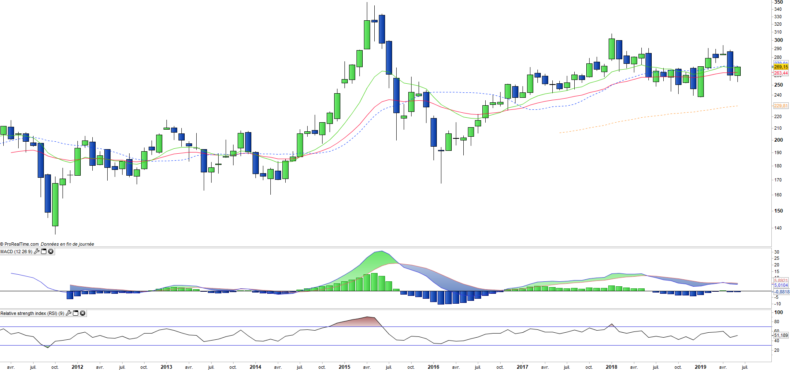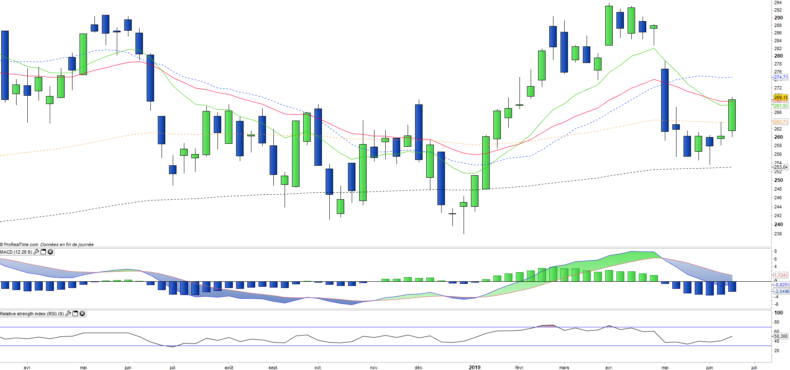Amundi ETF China (CC1) - 20/06/19
Short Term trend: Positive (60/100)
Long Term trend: Positive (55/100)
Scores computed by our proprietary algorithms - cf methodology
Characteristics of the ETF
The CC1 ETF (Amundi) created in 03/2009 is listed in EURO on Euronext and replicates the MSCI China-H net dividends reinvested index ("net return"), which is composed of the 50 main Chinese stocks listed in Hong Kong and composed for 2/3 of financial values.
These shares are subject to Chinese regulation but denominated in Hong Kong dollar (HKD). Chinese H shares, unlike A shares, are available to non-resident investors in China. The target for maximum tracking error between changes in the net asset value of the Fund and that of the MSCI China H Index is 2%.
This tracker presents a currency risk linked to the exposure of the MSCI China H Index, resulting from the evolution of the reference currency, the Hong Kong dollar (HKD). The fee of this ETF is 0.55% for an AUM of 92M €. The replication method is synthetic (via swaps).
Alternative ETFs: CSIA (Lyxor in Euro), FXI (iShares in USD)
Index profile
The equities that make up the MSCI China-H Index come from the universe of the most important stocks in the Chinese market.
The MSCI China-H Index is composed of 50 constituents, so it is relatively diversified. The financial sector (banks and insurance companies), however, accounts for about 67% of the capitalization while the China Construction Bank accounts for 15% of the index.
China is the world's second largest economy behind the US with a GDP of about $ 14200bn in 2018, the world's largest exporter with the world's largest foreign exchange reserves. The global recession of 2009 interrupted China's continued growth momentum, and the limits of its export-oriented growth model emerged. As a result of the global economic downturn and declining trade, Chinese growth decelerated to below 7% from 2015, its lowest level in 25 years.
State-owned enterprise debt accounts for 145% of GDP while private sector debt accounts for more than 200% of GDP. In addition, the quality of bank assets has deteriorated for several years and this trend is probably underestimated because of the importance of the shadow banking. Many challenges remain linked to the problem of an aging population, the lack of openness of the political system, the competitiveness of an economy dependent on high investment expenditure and the expansion of credit. The manufacturing and construction sectors contribute nearly half of China's GDP, but the country is increasingly relying on services and domestic consumption.
China has posted a 6.6% growth rate in 2018 and now expects growth between 6- 6.5% n 2019, which means a gradual soft landing linked to the new growth model, more based on quality, corresponding to an upscaling of industry and services, but also focused on reducing the current major imbalances (too high debt, overcapacity in industry and real estate). China no longer seems to be in the race for growth, but in search of a more balanced and sustainable model based on the upscaling of its industry through technology and the expansion of services and domestic consumption. China faces geopolitical problems with most of its neighbors (India, Japan ...) and especially in the China Sea, because of its plans for territorial expansion that could lead to military confrontations.
His confrontation with the US, at the commercial level, is turning into a strategic battle after the ban of Huawei, and could still evolve into a sort of high-risk cold war. Managing its relationship with the US will be crucial for China at least in the short term, that is, the next decade.
Monthly data
The monthly chart shows the long-term trend of the Chinese index, which is becoming increasingly flat and neutral. Bearish starts are regularly stopped as well as increasingly moderate increases. The volatility of the index is less and less strong, and it is less and less directional. However, moving averages and technical indicators remain positively oriented, which still makes possible a further upward swing.
Weekly data
The weekly chart shows a generally bullish but chaotic trend. The EMA200 plays the role of major support and has managed to stop the successive bearish starts since 2018. A rebound attempt is taking place from this support, but to be credible it will have to close the bearish gap opened in May.The technical oscillators turn around which favors a deepening of the current rebound.
Theme
CC1 is a UCITS ETF, listed in €, which seeks to replicate the MSCI China H index (50 chinese companies)
Characteristics
| Inception date | 03/03/2009 |
| Expense ratio | 0,55% |
| Issuer | Amundi |
| Benchmark |
MSCI China H
|
| Code/Ticker | CC1 |
| ISIN | LU1681043912 |
| UCITS | Yes |
| EU-SD Status | Out of scope |
| Currency | Euro |
| Exchange | Euronext Paris |
| Assets Under Management | 94 M€ |
| PEA (France) | Yes |
| SRD (France) | Yes |
| Currency risk | Yes |
| Number of holdings | 50 |
| Risk | 4/5 |
Country breakdown
| China | 100% |
Sector breakdown
| Financials | 67% |
| Energy | 8% |
| Industrials | 7% |
| Materials | 4% |
| Communication Services | 3% |
| Consumer discretionary | 3% |
| Health Care | 2% |
| Others | 5% |
Top ten holdings
| China Construct Bank | 15% |
| Ping an Assurance | 12% |
| ICBC | 9% |
| Bank of China | 7% |
| China Petroleum Chem | 4% |
| China Life Insurance | 4% |
| China Merchants BK H | 4% |
| Petrochina CO H | 3% |
| Agricult BK China-H | 3% |
| China Pacific Insur | 2% |


